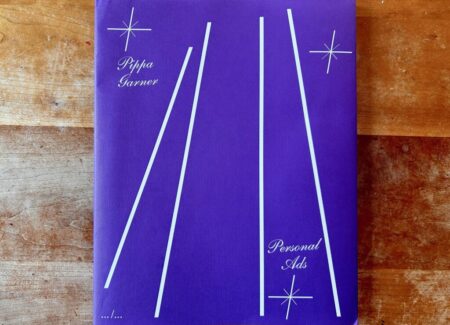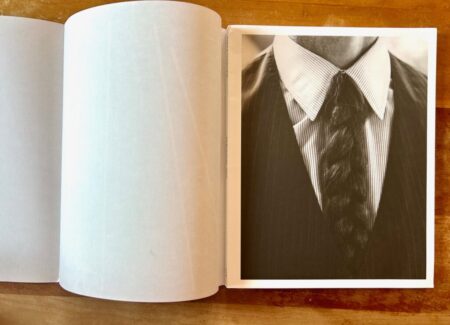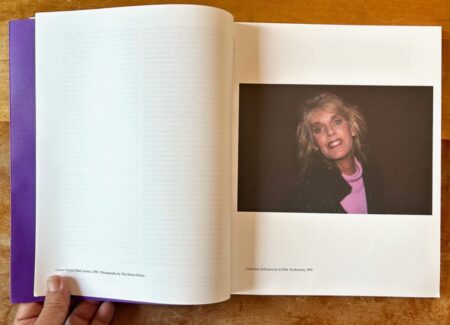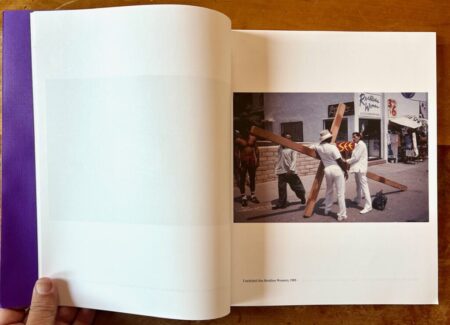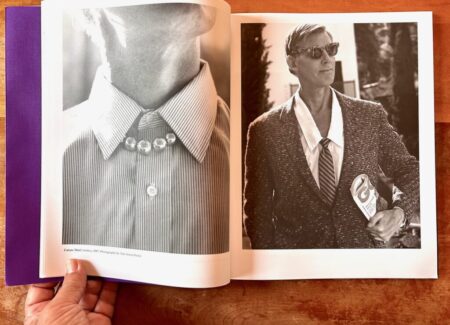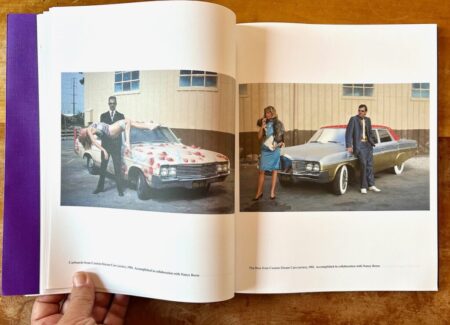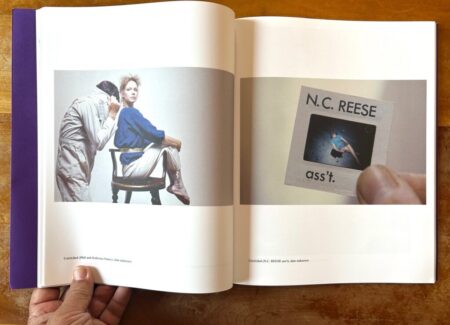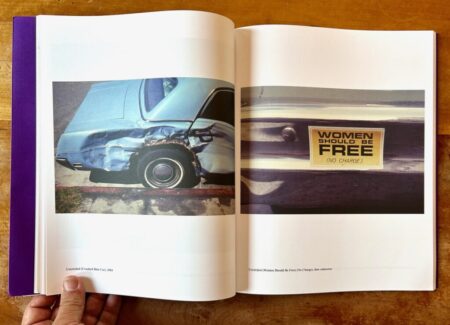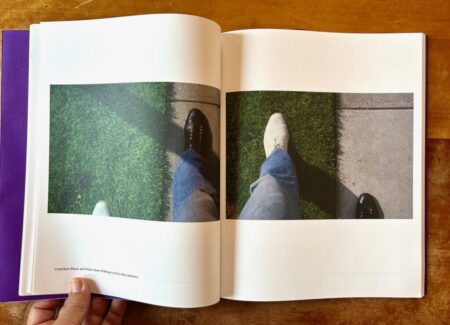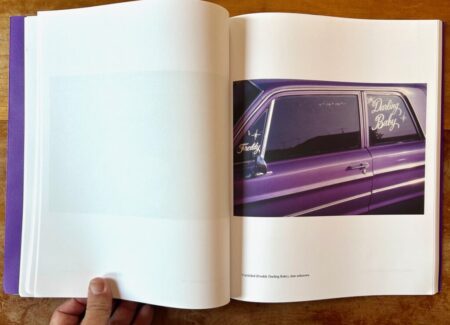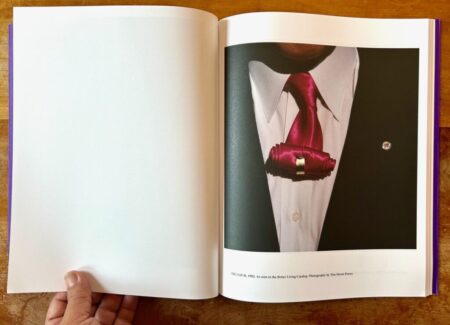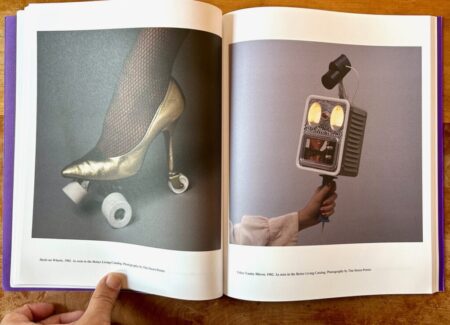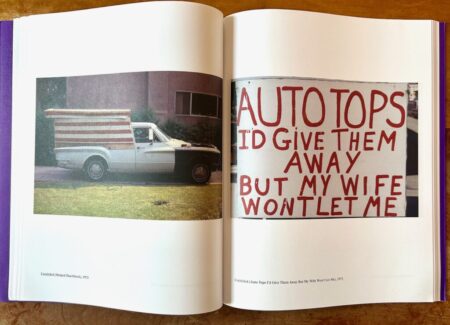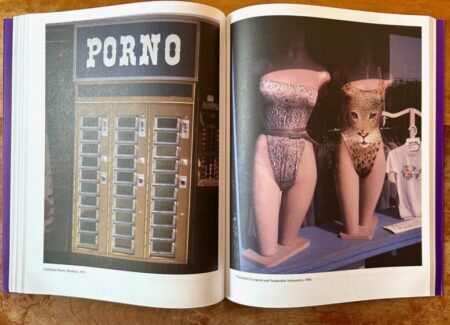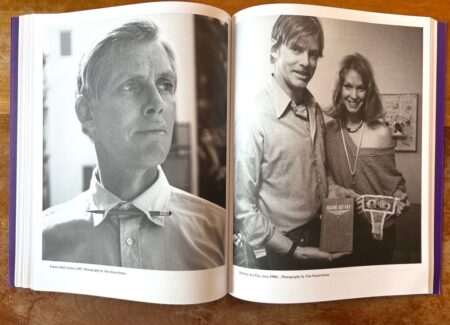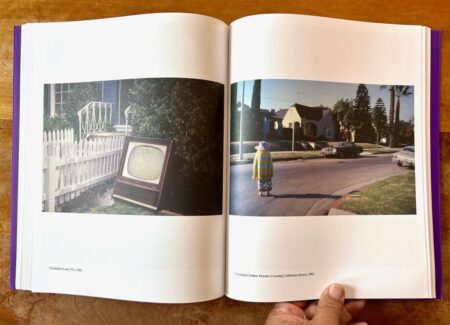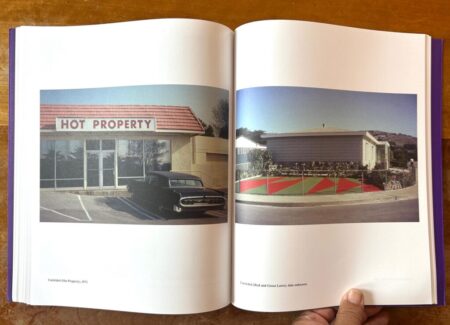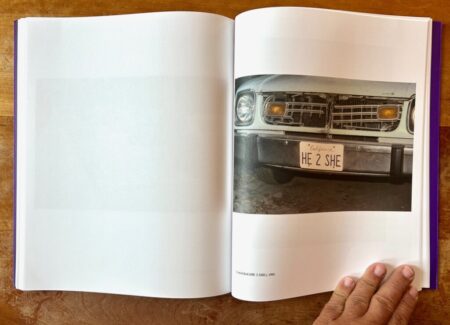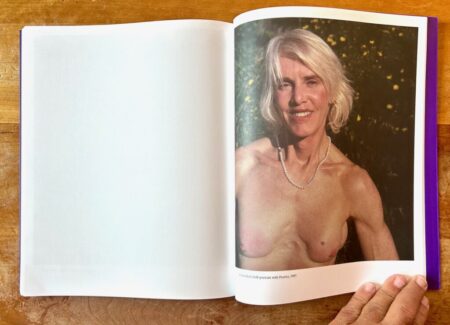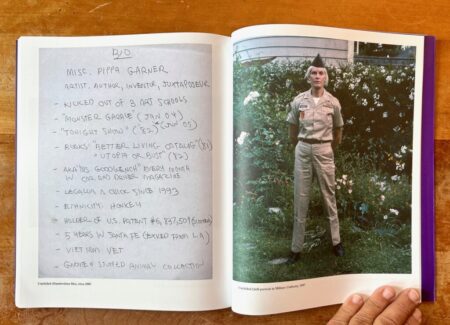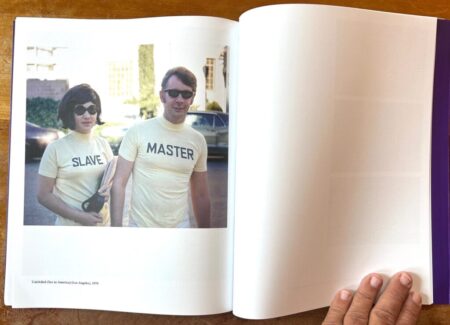JTF (just the facts): Published in 2025 by Art Paper Editions (here). Softcover with dust jacket, 24 x 30 cm, 112 pages, with 86 color and black-and-white reproductions. Includes an essay by Georgia Basch, and an interview with the artist conducted by Luca Lo Pinto. Design by Jurgen Maelfeyt. In an edition of 1500 copies. (Cover and spread shots below.)
Comments/Context: I must admit I was a latecomer to the wonderfully absurd crackpot schemes of Pippa Garner. Although her creative journey began in the 1960s, it was only seven months ago that she first came to my attention, spurred by a flurry of obituaries after her death on December 30th, 2024. She had succumbed to lymphocytic leukemia at age 82, shortly after her inclusion in the Whitney Biennial, on the heels of several recent monographs, and just as her artistic star was on the rise.
Reading the glowing tributes from various critics, collaborators, and friends, my curiosity increased. A self-described artist/author/inventor/juxtaposeur, Garner was a prolific creator, an artistic provocateur, and a consummate draftswoman. She was a cultural warrior, a satirist of post-war consumerism, and a gender-bending stalwart of the West Coast underground. In other words, she was right up my alley. How had I overlooked this force of nature? Where had she been hiding? And what made her tick?
For those seeking to get quickly up to speed on Garner, the new book Personal Ads is not a bad entry point. By design, this is not a comprehensive tome in the mold of the recent retrospectives $ELL YOUR $ELF or Act Like You Know Me. Instead, it’s a surface level survey, sampling various Garner endeavors in assorted sequence. As a vehicle for an artist who relished caricature, pranks, and whimsicality, it’s a nice fit.
Personal Ads shares dozens of Garner’s fashion and media projects from the early 1970s through 2005. Many are adapted from archival slides, and many are previously unpublished. It would be nice to learn more of their back history, but the book does not dive very deep. Instead the work is presented as a series of one-off images with brief captions. Garner refrains from contextual spin. “I don’t have any broader view of the influence of anything I’ve done,” she tells Luca Lo Pinto in the accompanying interview. “I just work. I put it out there and see what happens.”
And work she did, with scant letup. Garner’s output spilled across multiple genres including product design, drawing, advertising, sloganeering, body modification, and more. For the purpose of Personal Ads, all have been channeled through a single medium: photography. Or, to be more specific, a photobook.
Personal Ads flows in a torrent. Single images appear one per page, bouncing between years, prototypes, inventions, and campaigns. Most photos are shot by Garner, with a decent portion provided by collaborator Tim Street-Porter. Some of the pictures seem intended as art works in and of themselves. But most use the camera as a secondary recording tool. That is to say, the idea is the primary thing—and she had a lot of them—not the finished photograph. These two picture types blend rather seamlessly in the book, documenting selected products, concepts, and people. Garner appears regularly as a photo subject. She is shown at various ages and permutations, sometimes as Pippa, and sometimes as her pre-transition alter ego Phil. (The two seem to be on remarkably good terms.)
Lest the reader feel overwhelmed by the image blitz, blank pages offer occasional respite. They provide a moment to catch your breath before the next hare-brained whammy. Eventually the final page brings the title home with three personal ads commissioned for Los Angeles newspapers in 1995. Man-Made surgical doll post op transexpot, just out of the box, is a messenger from the Millennium, advertises one. Fully programmable pussycat invites attractive, thrill-seeking, alien friendly pet surfers for fembryonic fun fest. Garner certainly had a way with words. She also knew what she wanted and how to get it.
But we’re getting ahead of her life story. By the time Personal Ads picks up Garner’s trail in 1971, she was already well advanced on her creative path. Let’s go back a moment to the Chicago suburbs in the post-war years. This is where Garner was born (1942) and raised in the body of a boy named Philip. Ethnicity: Honkey. Her father was an advertising executive, an unwitting foil as it turned out for her subsequent subversions of capitalism, masculinity, and middle class convention. One could say the backlash to mad men fostered a mad scientist.
A brief stint in the 25th infantry in Vietnam reinforced Garner’s rebellious streak (manifested in a later self-portrait in her service uniform, worn as a trans-woman). The military didn’t suit her. On the positive side, the Army’s Combat Art Team was a subsidized opportunity to refine her drawing skills. Once discharged, she moved to Los Angeles to pursue design studies in earnest, and an eventual career as a professional illustrator. Los Angeles proved a good fit for Garner, and she settled there for good. She came to view the city as “kind of a gadget in and of itself, constantly being torn down and rebuilt.” An urban metaphor for her creative process.
With commercial gigs paying the bills, Garner was free to follow her muse wherever it might lead. Numerous detours arose. An early sculpture blending a half-car with half-nude figure got her booted from art school, while a later prototype featuring reversed auto chassis—fully drivable at highway speeds—earned rave reviews. “In my earlier work, I was always using objects that were consumer goods, things that came off assembly lines,” she explained. Her inventions combined mother necessity with blunt parody, with strains of both James Bond and Al Jaffee. She created a bare midriff cut-off suit top (worn by Phil Garner on Johnny Carson’s “Tonight” show), a high heeled roller skate, a bra-mounted beat box, and much more. Zany ideas. But still, one wondered, why didn’t I think of that?
Many examples were collected in Garner’s 1982 publication Better Living Catalog: 62 Absolute Necessities for Contemporary Survival, and the 1984 followup Utopia—or Bust! Products for the Perfect World. Her creations were brilliant and prolific, despite being wildly impractical. Nevertheless they had some staying power. Many product images can still be found online, and several resurface in Personal Ads.
Browsing this posthumous tome, Garner’s primary interests become clear. Top of the list is her lifelong fascination with automobiles. The backward chassis was just the tip of Garner’s iceberg. She felt an intimate connection with motor vehicles, beginning as a teen working an auto assembly line. Later, as an adult in LA, a personal car became a necessary accessory—if not a bodily appendage—and Garner was off and rolling. Automobiles became a recurring component of her sketches and sculptures. Taking daily walks—it’s fun to imagine her bumping into Corita Kent or Ed Ruscha in West Hollywood—unusual cars might catch her eye. She might photograph a so called “Rebel Car”, or a Nix On Nixon bumper sticker, or odd sedans shrouded in mirrors or canvas. How about a “Tail Gating Sun Bathing” with a friend? Or a series of Custom Dream Cars staged with partner Nancy Reese? Personal Ads nips at the archive, documenting all of the above. For much more in this vein, readers should seek out APE’s companion photobook Pippa Garner Bad Cars.
For post-war Boomers, the natural counterpart to the car was the business suit. Garner viewed the de rigueur male uniform with some skepticism, a symbol of conformity, patriarchy, orthodoxy, and the establishment. Fair game to any satirist worth her salt. Several examples in Personal Ads showcase her salaryman fashion tweaks, many created as part of her Future Man! series (modeled by Phil Garner). A pocket-mounted LED name tag might come in handy during the next power lunch, while a suit with plunging neck line could introduce male cleavage to the conference room. Heck, why not wear two ties side by side? Or roll up that fussy diamond end like a party blower? How about a fur tie? Or mini-ties worn as shin guards? A photo of a man wearing his tie neatly displaced two inches to one side encapsulates the collective message of these broad efforts: neck-ties are pure adornment after all, with no functional purpose. Shots fired. Too fat a target? Yes, perhaps. Still, Garner’s jabs land with existential force. Gut punches to the empire.
If automobiles and neckties were two sides of the same hegemonic coin, they exemplified a central theme in Garner’s work: she liked to work in dualities. She was constantly comparing and contrasting oppositional ideas, and her projects demonstrated a sort of Mad magazine version of the Hegelian dialectic. Her pairings were too silly to take at face value, but they coalesced into grains of truth.
Binary ideas might manifest in a sign dividing “beautiful people” from “others”, a “He 2 She” license plate, a matched pair of photos mirroring black and white foot wear, a blonde in a blonde room, a pair of his/her dancing shoes joined at the toe (shoes were yet another core interest), or a couple in matching “Slave” and “Master” T-Shirts.
These last two might have been found in passing, or perhaps Garner created the slogans herself. A handwritten list in Personal Ads shares some of the numerous T-Shirt dualities she imagined. I Was A Self-Abused Child. I Wanna Be Just Like You. Are You Pessinoid Or Paramistic? High-Concept Dirt Bag. Which if any of these phrases made it onto actual t-shirts? That’s hard to say. Garner was renowned for creating and wearing her own slogans. But Personal Ads does not clarify which ideas were realized.
The ultimate personal expression of dualism was Garner’s own gender transition. “I remember looking in the mirror one day,” she explained once in an interview, “and I thought, ‘Hey, I’m an object, too. I’m just another appliance.’” Why not rearrange the wiring? What’s a human body but artistic putty? Hers was as malleable as any material, at least in theory.
But alas, she was too far ahead of her time. When she began to investigate the possibilities in the mid 1980s, transsexualism was still largely underground and secretive. She eventually sourced hormones on the black market, procured on a Hollywood street corner. She later underwent some physical modifications including surgery and tattoos. A 1997 portrait in the book shows her happily settled into feminine form. She is bare topped with a pearl necklace, nipples pierced, long hair windswept, smiling warmly: Philippa “Pippa” Venus Garner.
When it came to her transition, Garner was an open book. She spoke openly about the medical roadblocks. As with most other things in her life, her alt-gender was also a source of humor. A handwritten list in Personal Ads collects various witticisms. Created circa 1990s, this one is titled “Notes On Sex Change – Reason and Wisdom Gained.” The chick is in the mail. Never found the right girl so built one in. Always wanted to nurse small animals. On-board trophy wife. More potential T-Shirt ideas?Maybe. In any case, they defanged the identity politics.
From Personal Ads, one gains the impression of an artist who was always on, always satirical, always keeping reality at arm’s length. Traumas may be easier swallowed as parody. Fair enough. But surely there was more to Garner. She must have been earnest and real with friends or close confidants. The book’s conversation between Garner and Luca Lo Pinto moves tentatively in this direction. They discuss LA, the art world, and Pippa’s thoughts on epochs and aging. The conversation is revealing but unfortunately brief, and the reader is still left guessing at much of her essence. Who was this force of nature? What made her tick?
More books on Garner will surely be forthcoming. They may fill in some of the blanks, but not all. If her legacy will always contain unanswered questions, she would likely be pleased.
Collector’s POV: The estate of Pippa Garner does not appear to have consistent gallery representation at this time. Collectors interested in following up should likely connect directly with the artist’s estate via her Instagram account (linked in the sidebar).
